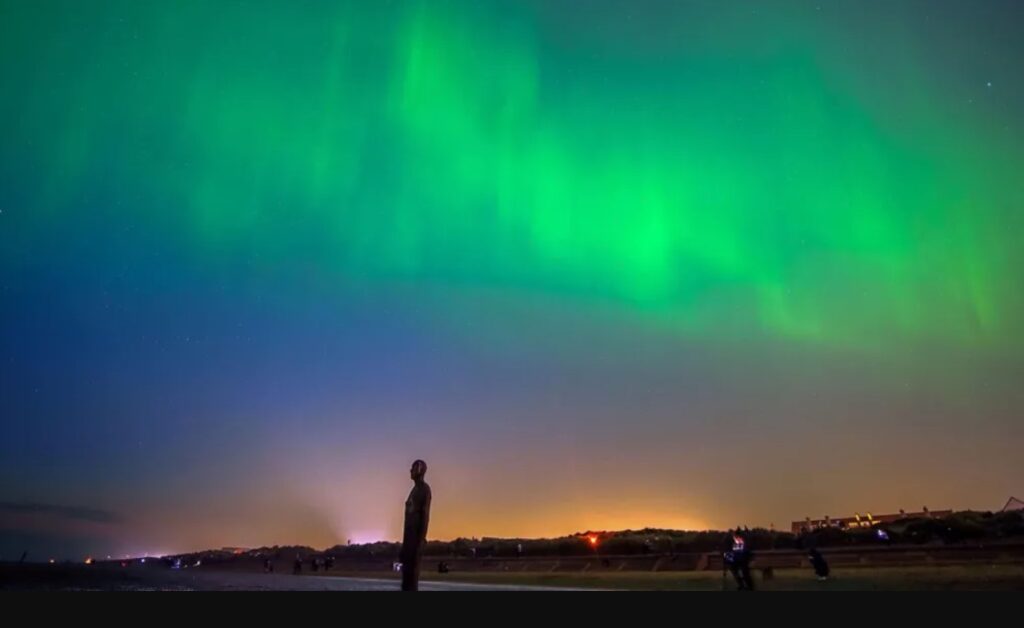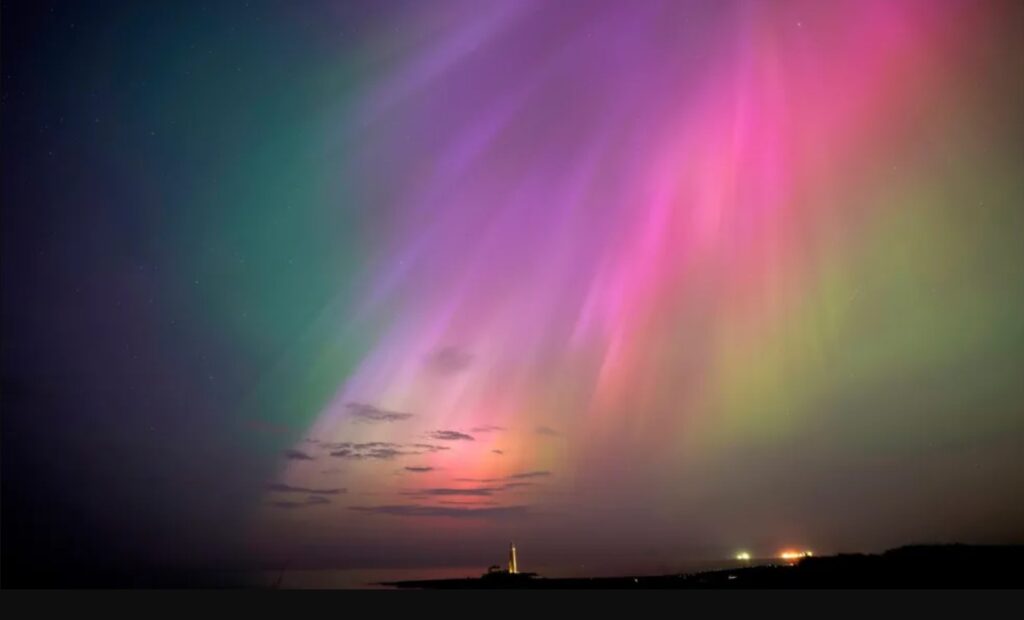The United Kingdom is currently experiencing a celestial spectacle that has left skywatchers in awe – the stunning Northern Lights, also known as the Aurora Borealis. This captivating natural phenomenon has made a rare appearance across the UK, thanks to a powerful geomagnetic storm caused by a solar event. This article will explore the magic of the Northern Lights and delve into the unique circumstances that have allowed them to be spotted in the UK.
What are the Northern Lights?
The Northern Lights, scientifically referred to as the Aurora Borealis, are a mesmerizing display of lights that occurs in the polar regions. This celestial phenomenon is caused by the interaction between charged particles from the sun and the Earth’s magnetic field. When these particles collide with atoms and molecules in the Earth’s atmosphere. Moreover, they release energy in the form of light, creating vibrant ribbons or curtains of color that dance across the night sky.
The Solar Storm of 2024

The recent sightings of the Northern Lights in the UK are the result of a rare solar storm that took place in 2024. As the CME interacts with the Earth’s magnetic field, it triggers a chain reaction that intensifies the activity of the Northern Lights. The resulting surge in solar particles bombarding the Earth’s atmosphere creates a spectacular and widespread display of the aurora borealis.
Why are the Northern Lights visible in the UK?
The Northern Lights are usually visible in regions closer to the Earth’s magnetic poles, such as Iceland, Norway, and Canada. However, on rare occasions, people can see them in more southern latitudes, including the UK. Increased solar activity and geomagnetic storms are often associated with this phenomenon. These storms cause fluctuations in the Earth’s magnetic field, which allows the Aurora Borealis to be visible at lower latitudes.
Notable Sightings and Experiences
Excited skywatchers across the UK have shared awe-inspiring pictures of the Northern Lights from various locations, including Liverpool, Kent, Norfolk, Sussex, and parts of Scotland. The clear skies and the heightened solar activity have provided optimal conditions for viewing this celestial wonder. These sightings have left both locals and visitors mesmerized by the ethereal beauty of the dancing lights. Photographers and stargazers have been capturing stunning images, sharing their experiences, and adding to the allure of the Aurora Borealis

BBC Weather presenter Elizabeth Rizzini has highlighted the fantastic conditions for viewing the lights. She mentioned mostly clear skies across the UK, with the possibility of low clouds in certain areas. Rizzini expressed optimism that the lights would be visible not only on the sighting night but also in the following days. The Met Office spokesperson, Stephen Dixon, hinted at favorable conditions continuing, with further details to come.
Geomagnetic Storms
Impacts of Geomagnetic Storms on Earth
Geomagnetic storms affect Earth, causing grid voltage issues, satellite problems, radio blackouts, and GPS navigation disruptions. Additionally, powerful geomagnetic storms can result in the aurora borealis (northern lights) being visible further from the poles than usual. G4 storms, in particular, have the potential to spark the Aurora Borealis as far south as Alabama and northern California.
Formation and Origin of CMEs
CMEs often originate from magnetically disturbed regions called sunspots in the Sun’s upper atmosphere or corona. Scientists do not fully understand the relationship between solar flares and ejections, although they can be associated. CMEs travel outward through the solar system, with some directed toward Earth while others completely miss our planet. CMEs are more likely to occur during the solar maximum phase of the sunspot cycle when sunspots and magnetic disturbances on the Sun are more prevalent.
Classification of Geomagnetic Storms
Geomagnetic storms, classified on a scale of G1 (minor) to G5 (extreme), consider G4 storms as “severe.” During an 11-year solar cycle, there are typically around 100 G4 storms. However, since the beginning of the current solar cycle in December 2019, observers have only observed three G4 storms. The most recent G4 storm occurred on March 23, 2024.
Current Geomagnetic Storm Forecast
The current forecast suggests that the first three of the five CMEs heading toward Earth may combine into a “cannibal CME.” This phenomenon occurs when faster-moving CMEs overtake and merge with slower-moving ones. Expect the cannibal CME to induce G3 storms. Furthermore, anticipate the effects of the fourth and fifth CMEs to elevate the geomagnetic storm level to G4.
Recommended Reads
Bernard Hill: ‘Titanic’ and ‘Lord of the Rings’ Actor Died at 79
Exploring Japan: A Land of Tradition, Innovation, and Natural Beauty
Remarkable Women’s History & Fun Facts – Factscover.com
Some Cool Mushroom Facts You Didn’t Know
Tips for Observing the Northern Lights
- Stay Informed: Keep an eye on space weather forecasts and alerts to increase your chances of witnessing the Northern Lights.
- Find Dark, Clear Skies: Minimize light pollution by heading to areas with minimal artificial lighting, such as remote countryside locations or coastal areas.
- Dress Warmly: During your outdoor adventure, it is advisable to dress appropriately to ensure comfort. Especially during the colder months when the Northern Lights are often at their best viewing times.
- Be Patient: Be prepared to wait for the perfect conditions and be patient in your quest to witness this breathtaking display. But, Seeing the Northern Lights is not guaranteed.
- Capture the Moment: Bring a camera capable of long exposures and low light settings to capture the magic of the Northern Lights and preserve the memories.
Final Thoughts
The rare appearance of the Northern Lights across the UK has ignited a sense of wonder and awe among skywatchers. The captivating dance of lights against the night sky has created a magical atmosphere, leaving an indelible mark on those fortunate enough to witness this celestial spectacle. As the solar storm continues to unfold, those in the UK eagerly await the opportunity to witness the Northern Lights once again. Furthermore, deepening their appreciation for the wonders of the universe.
FAQ’s
The northern lights, also called the aurora borealis, grace the night skies of the northern hemisphere. The Northern Lights are seen between 60-75 degrees latitude in Canada, Norway, Sweden, Finland, Alaska, Russia, and Iceland. They appear mostly from 10 p.m. to 2 a.m. but can show up at any hour as long as conditions are dark.
The best time to see the northern lights is from September to April when there are longer and darker nights, providing ideal observation conditions. This period coincides with increased solar activity, which enhances the chances of witnessing this celestial phenomenon. September and March typically boast the highest solar activity. Nonetheless, it’s essential to consider factors like darkness, clear skies, and solar activity, which can vary depending on your location.










